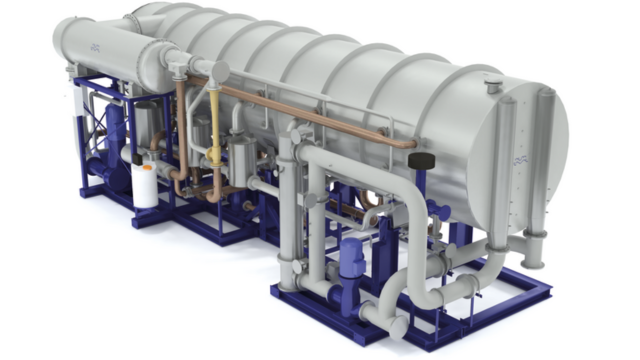MEP - Wielostopniowy wyparownik płytowy
Świeża woda jest niezbędna na pokładzie każdego statku i musi być dostępna w każdej chwili. Niezależnie od tego, czy jest przeznaczona do spożycia przez ludzi, czy do wykorzystania w procesach operacyjnych, musi być dostępna w dowolnym miejscu na świecie. Dzięki parowaniu MEP można nadal korzystać z wysokiej czystości świeżej wody, nawet w trudnych, zmiennych warunkach zewnętrznych.
Wydajny generator świeżej wody o dużej pojemności
- Niskie zużycie ciepła i energii elektrycznej
- Utrzymuje wydajność i produktywność w zimnej wodzie morskiej lub płytkiej wodzie
- Może pracować na wylocie pary z generatora turbiny parowej
- Zapewnia wysoką czystość destylatu na poziomie 5-10 ppm
- Woda może być używana do celów pitnych lub technicznych w zależności od potrzeb
Ze względu na sposób, w jaki MEP wykorzystuje ciepło odpadowe, ogólny koszt eksploatacji jest niski. Ta solidna, niezawodna technologia została również zaprojektowana z myślą o łatwym serwisowaniu, co oznacza, że korzystasz z minimalnego czasu przestoju, a także faktu, że MEP utrzymuje wydajność w zimnych lub płytkich wodach, co dodatkowo poprawia dostępność systemu.
Cechy
Zaprojektowana wydajność - niski pobór ciepła i energii elektrycznej
Prosta obsługa i zautomatyzowane sterowanie zapewniają maksymalny czas pracy przy niższych kosztach w porównaniu z technologiami takimi jak odwrócona osmoza (RO) i wielostopniowe płukanie (MSF). Jego lekka, zajmująca niewiele miejsca konstrukcja zajmuje mniej miejsca na podłodze, oferując jednocześnie znacznie wyższą wydajność termiczną oraz niższe zużycie energii elektrycznej w stosunku do jego objętości i wagi w porównaniu do innych wysokowydajnych parowników. Umożliwia to produkcję znacznie większych ilości świeżej wody niż w przypadku innych technologii odsalania.
Doskonałe rozwiązanie dla statków wycieczkowych, RoPax i transportowców, a nawet więcej, jeśli są zasilane LNG
Ta technologia działa wyjątkowo dobrze na statkach napędzanych LNG, ponieważ zazwyczaj mają one więcej nadmiaru dostępnego ciepła, a MEP działa na odzyskiwanie ciepła odpadowego. Ponieważ coraz więcej armatorów chce przejść na LNG ze względu na przepisy dotyczące emisji, MEP jest idealnym rozwiązaniem do dalszej redukcji kosztów. Fakt, że system ten wymaga mniej energii i lepiej ułatwia przejście na LNG, oznacza również, że może on uczynić statki znacznie bardziej przyjaznymi dla środowiska.
Technologia płyt
Wyparki Alfa Laval MEP - Wieloefektowy parownik płytowys to generator świeżej wody o wysokiej wydajności który składa się z szeregu tytanowych płytowych wymienników ciepła, które zostały specjalnie zaprojektowane do tego celu. Wszystkie płyty są identyczne; z dwoma konfiguracjami uszczelek wykorzystywanymi w celu utworzenia zarówno skraplającego, jak i parującego kanału płytowego. W porównaniu do tradycyjnej technologii płaszczowo-rurowej, technologia płytowa zapewnia wyższą sprawność cieplną. Ciągła cienka warstwa wody na całej powierzchni płyty minimalizuje również ryzyko gromadzenia się osadów (kamienia), a tym samym przestojów. Odporne na korozję tytanowe powierzchnie wymiany ciepła i niepowlekane materiały są odporne na wodę morską i solanki.
Zasada działania
Zasada działania
Proces odsalania Alfa Laval MEP obejmuje szereg komór parowania i kondensacji zwanych efektami, z których każda wyposażona jest w opatentowane płyty Alfa Laval. Woda morska jest podgrzewana i częściowo odparowywana w tych komorach, wytwarzając opary destylatu, które są następnie skraplane do czystego destylatu w następnej komorze.
Dzięki utrzymywaniu różnicy ciśnień cząstkowych pomiędzy efektami, system maksymalizuje wydajność przy wykorzystaniu energii cieplnej niskiej jakości. Liczba efektów w jednostce określa jej wydajność i koszt.
Woda morska jest pompowana do systemu, działając jako czynnik chłodzący w skraplaczu, gdzie para z ostatniego efektu jest skraplana do czystego destylatu. Ciepło ze skroplonej pary jest przekazywane do wody morskiej, która jest następnie wstępnie podgrzewana i kierowana na stronę parowania stosu płyt. Specjalna konstrukcja płyt zapewnia równomierny przepływ i minimalizuje osadzanie się kamienia. Woda morska jest częściowo odparowywana przez ciepło ze strony kondensacji, a wytworzona para jest przepuszczana przez odmgławiacz w celu usunięcia soli przed skropleniem do wody destylowanej w następnej komorze.
Proces ten jest powtarzany we wszystkich efektach, z destylatem i solanką ekstrahowanymi z ostatniego efektu. System działa w warunkach podatmosferycznych, utrzymywanych przez napędzany wodą wyrzutnik, który usuwa powietrze i nieskraplające się gazy.
Skontaktuj się z naszymi ekspertami już dziś, aby dowiedzieć się, w jaki sposób wieloefektowa wyparka płytowa MEP może zoptymalizować Twoje operacje.
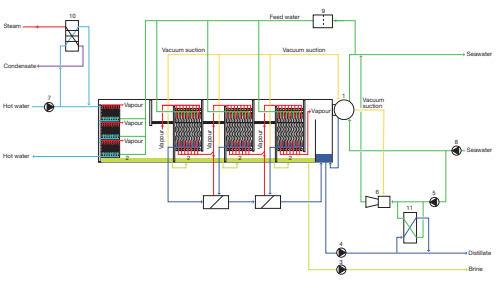
Case stories
Systemy Alfa Laval są obecne na prestiżowym statku Norwegian Escape
W październiku 2015 r. Norwegian Cruise Line (Norwegian) odebrał pierwszy statek nowej klasy Breakway Plus. Norwegian Escape o pojemności 164 600 GT to nie tylko największy jak dotąd statek wycieczkowy Norwegian, ale także jeden z największych statków wycieczkowych na świecie. Na pokładzie znajdują się znane systemy Alfa Laval w szeregu kluczowych zastosowań, w tym Alfa Laval MEP.
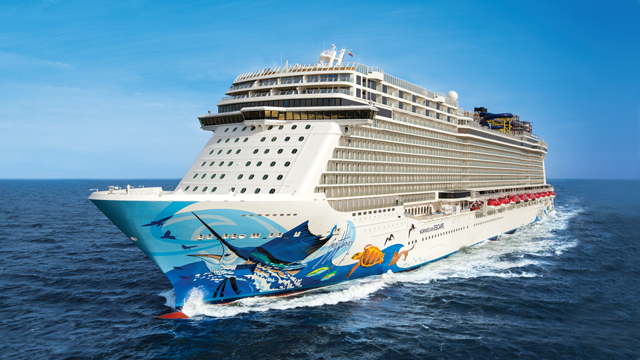
Zapewnienie wysokiej jakości wody na potrzeby energetyczne Krety
Grecka spółka Public Power Corporation stanęła przed poważnym wyzwaniem: pozyskaniem wody o wymaganej jakości do produkcji energii w elektrowni Atherinolakkos na odległym południowo-wschodnim wybrzeżu Krety. Dowiedz się, jak pokonano tę przeszkodę dzięki innowacyjnej technologii odsalania Alfa Laval. Dowiedz się więcej o tym przełomie i jego wpływie na przyszłość energetyczną Krety.
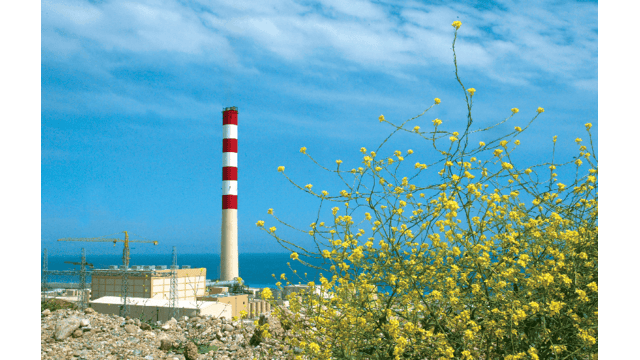
Technologia wytwarzania świeżej wody zapewnia wydajność energetyczną
Clive Woodbridge, Passenger Ship Technology, 3 kwartał 2015 r. - Producenci sprzętu nadal zmniejszają zużycie energii Dwa wysokowydajne parowniki Alfa Laval typu MEP-6-900 zostały zainstalowane na statku Norwegian Breakaway. Każdy z nich jest w stanie wyprodukować 900 m3 wody dziennie
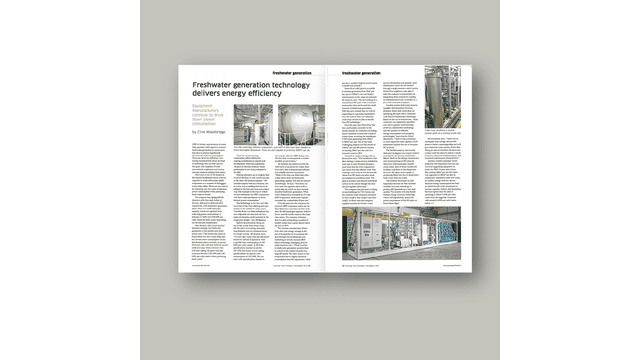
Sieć serwisowa dla branży morskiej
Działający na całym świecie, 24/7, serwis Alfa Laval Marine to Twoja przepustka do większej dyspozycyjności, zoptymalizowanej wydajności i prawdziwego spokoju ducha. Jesteśmy zawsze w pogotowiu, a nasza oferta serwisowa zapewnia niezawodność, wydajność i zgodność z przepisami przez cały okres eksploatacji Państwa urządzeń.
24/7 Serwis i Wsparcie
Dział morski w Gdyni
ul. Sportowa 8, 81-300 Gdynia

